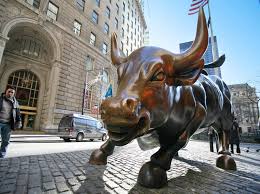Happy Birthday, Bull Market! It May Be Your Last

Wall Street this week celebrated the arrival of a bronze-cast defiant girl staring down its iconic charging bull statue, installed in honor of International Women’s Day.
But the proverbial bull is also celebrating a milestone of its own: The bull market in U.S. stocks turns eight years old on Thursday, March 9.
The current bull market, defined by prices that continue rising without being interrupted by the 20% decline that would signify a bear market, began for the S&P 500 exactly eight years ago, in the depths of the recession in 2009. Since then, the benchmark index has gained 249%, with just four official corrections—defined as a decline of 10% or more—the last of which happened in the beginning of 2016, according to Yardeni Research.
And while signs of a stock market bubble have abounded recently, from the Trump Bump rally sending the Dow Jones industrial average to new highs, to Snapchat’s mega IPO last week in which even Uber drivers were snapping up Snap (snap) stock, the current bull market is not particularly remarkable. As bull markets go, this one is not yet the longest, nor the best in terms of performance, nor even the most expensive.
So, to paraphrase the Broadway musical “Rent,” how do you measure a bull market?
At 96 months old, this bull market is not the oldest in modern history (post-World War II): That title goes to the bull market that lasted from the fall of 1990 to the early spring of 2000, or 113 months, according to CFRA and S&P Global, before spectacularly flaming out in what has since become known as the dot-com bust. That record dot-com bull market, which is also the best-performing, with a 417% gain, lasted just more than a year longer than the current bull market’s age. No bull market has ever made it to its 10th birthday.
The current bull market isn’t even the the runner-up in performance: The baby-boom bull market in the 1950s is the second-best performer, with the market having risen 267% during its seven years. Nor is the ongoing bull market the one in which stocks became most expensive, though it’s getting close. The S&P 500 was trading at a multiple of 30 times earnings when the dot-com bubble burst in 2000, and 26 times earnings when it was the same age as the current bull; today, the S&P 500 has price-to-earnings multiple of about 25.
How long does this bull market have yet to live? No one knows for sure, but because bull markets age in what you might call dog years, if it were a human it would be very, very, very old. The average American lifespan, despite a slight decline recently, is about 79 years, or 948 months. The average age of a bull market, meanwhile, is 57 months. So, if you assume that every bull-market year is equivalent to about 16.6 human years (948 months divided by 57 months), this eight-year-old bull market is actually 133 years old. (The oldest person on Earth is currently 117.)
Still, as Sam Stovall, chief investment strategist for CFRA points out, historically, the longest bull markets “went out with a bang and not a whimper. Like an incandescent light bulb, they tend to glow brightest just before they go out.” The S&P 500 has already blown through Wall Street’s targets for the end of 2017, forcing Stovall and others to raise their expectations. modestly, for another 4% to 10% rise this year. That would pale in comparison to the 36% surge the S&P 500 posted in the year leading up to the ninth birthday of the dot-com rally.
Don’t count out the current bull market’s ability to celebrate its golden birthday on March 9 next year with similarly impressive returns. Writes Stovall in an eloquent research note this week, “Bull markets don’t die of old age, they die of fright. And what they are most afraid of is recession.” At the moment, even economists including Fed chairwoman Janet Yellen aren’t all that worried about a recession anytime soon.


